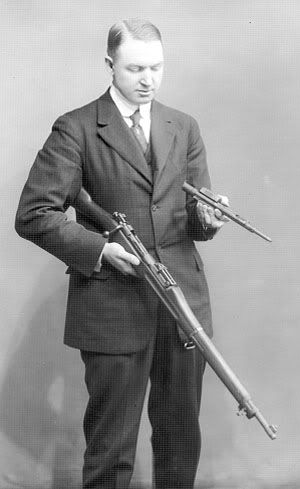I was doing research recently for an article on the Remington-UMC Model 51 pocket pistol, which was designed by John D. Pedersen. I was intrigued to find information on him, and thought I'd share what I found.
John
John Douglas Pedersen was born in Grand Island, Nebraska on May 21, 1881. His parents, Danish immigrants, were ranchers and John grew up in Jackson Hole, Wyoming. Young John traveled extensively, and proved to have a keen knack for mechanical things. His educational credentials are unknown, but in the second decade of the 20th Century, he went to work for Remington-UMC as a designer.
Pedersen is most remembered for inventing the top secret Pedersen device of WWI, which was a semiautomatic conversion for Model 1903 Springfield Mark I rifles. It utilized a .30 caliber pistol-sized round. These devices came on stream too late to be utilized for the war, and most of the 65,000 produced were later destroyed, making existing examples quite valuable.
He designed a number of sporting guns for Remington in addition to the innovative Model 51 pistol. These included the Model 10 pump shotgun and the Models 12, 14, and 25 pump rifles. He refined John Browning’s initial work to develop the Model 17 20-gauge shotgun, which served as the basis for the Remington Model 31, the Browning BPS, and the Ithaca 37. He also designed a .45 semiauto pistol based on principles used in the Model 51 pocket pistol. The resulting Remington Model 53 was accepted by the U.S. Navy for production, but when WWI started, the Colt/Browning Model 1911 became standardized, and his pistol was never produced.
During WWII, Pedersen teamed with the Irwin family of Grand Rapids, Michigan, who manufactured furniture. Their new company, the Irwin-Pedersen Arms Company, contracted to manufacture 100,000 M1 carbines. Due to many difficulties, the company manufactured only 3,500 carbines, none of which met military standards, and as a result, the facilities were taken over by the Saginaw Steering Gear division of General Motors. Irwin-Pedersen carbines are rarely encountered today and bring premium collector prices.
In the 1920s, the Army Ordnance Corps selected his .276 Pedersen cartridge to become the new combat rifle standard. However, Army Chief of Staff Gen. Douglas MacArthur nixed the idea in favor of keeping the older .30-06, a decision which helped streamline supply lines in WWII. Pedersen also designed a rifle that competed with John Garand’s prototype M1 rifle, utilizing a Luger-like toggle mechanism and waxed cartridges. It was tested by the British as well as in America; Vickers made a number under contract. Although this design was not successfully adopted, the Japanese copied it in 6.5mm caliber and made about a dozen rifles and an equal number of carbines, some of which were encountered by our troops on Okinawa. The Japanese apparently did not realize that the arm required waxed cartridges to operate correctly, and the rifle was a dead-end failure for Japan.
In his lifetime, Pedersen was granted over 70 firearms patents and was highly regarded in the arms industry. Although he finally maintained a home in Blandford, Massachusetts, he continued to travel widely. He died of a coronary at age 70 while visiting Cottonwood, Arizona on May 23, 1951. His son Eric served as a Marine officer in the Korean War. He was featured in the book
Reckless: Pride of the Marines. Lieutenant Pedersen led a recoilless rifle platoon and had used his own funds to purchase a racehorse for ammunition-carrying duties. That horse, named “Reckless”, became the mascot of the First Marine Division, participated in an amphibious landing, and received the honorary rank of sergeant, living out her final days in Camp Pendleton, California.
John Browning, no slouch in the gun design field, told Gen. Julian Hatcher once that he thought John Pedersen was possibly the best in the world. That's a pretty high accolade!

